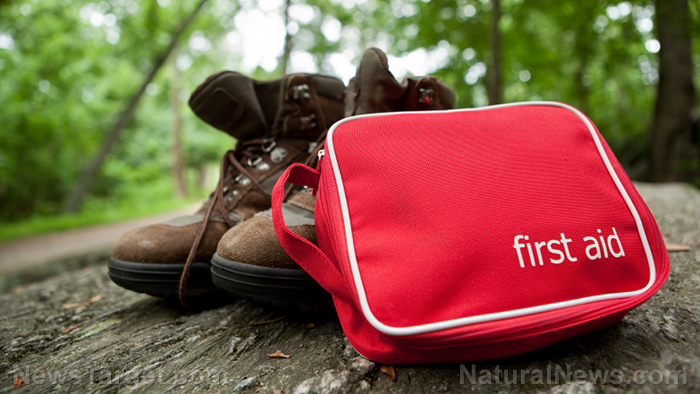Survival first aid: How to treat acid and base burns
07/02/2020 / By Zoey Sky

When SHTF, anything can happen. You can get lost in the woods, you may lose your gear, or you can injure yourself. As a prepper, you give yourself an advantage by knowing how to address these survival situations.
Knowing first aid is important and it allows you to treat medical emergencies like chemical, or caustic, burns. (h/t to PreppersWill.com)
Acids and bases
Acids and alkaline bases are found in laboratories, retail stores or inside your home. The pH scale ranges from 0 to 14: 0 is acidic; 7 is neutral; and 14 is alkaline (basic). The pH level of a solution indicates its acidity or alkalinity (base).
Acids
Acids are compounds with a pH below 7. Acids react with metals and produces a chemical salt and hydrogen gas. Acids are usually caustic, meaning they can burn skin and eyes.
You can find acids in concrete cleaners, drain cleaners, storage battery electrolytes and various household materials.
Bases
Bases have a pH above 7 and they react with acids to form a chemical salt and water via a neutralization reaction. When you mix acid and base in proper proportions, you will produce a salt solution with a pH of 7. However, bases can also be caustic like acids.
You can find bases in drain cleaners, jewelry cleaners, oven cleaners, lye and other common cleaning solutions.
Similarities and differences between acids and bases
Both acids and bases are caustic and you can find them anywhere: At home, school or your workplace. When acid attacks body tissue, your body forms a protective film to minimize the damage.
But when a base attacks body tissue, it can dissolve it. Note that while both acids and bases can damage human tissue, the latter can cause damage deeper into the affected tissue.
Modes of exposure to acids and bases
People may be exposed to acids and bases in three different ways:
Ingestion
Acids and bases are usually accidentally ingested by toddlers.
The ingestion of acids and bases can make the mouth area reddish, swollen and blistered. The throat may show similar visible signs of exposure to a caustic material.
When treating the patient:
- Dilute the ingested material with milk or water. Never induce vomiting: This will only re-expose damaged tissue to the caustic agent.
- Monitor the patient’s respiratory effort. As the chemicals passed through their upper digestive tract, it also passed through the patient’s upper respiratory system, which can cause airway obstruction via edematous (swollen) tissue.
If you are taking the patient to the emergency room, bring the container of the ingested solution.
Inhalation
The accidental inhalation of caustic agents is uncommon, but it may occur during laboratory or transportation incidents.
Like with ingested caustic chemicals, the patient’s upper airway can become partially obstructed due to edema or swelling due to fluid buildup. Ingestion can also cause lung tissue damage.
When treating the patient:
- Keep the patient in a sitting position.
- Give the patient 100 percent oxygen using a face mask with a reservoir bag, if possible.
- If the patient experiences a burning sensation in their skin or eyes, tend to it immediately.
Direct contact
If an acid or base comes into direct contact with skin, immediately flush the affected area with water. When in a laboratory or industrial environment, use safety showers. If the patient’s torso has been exposed to the agent, it is best to remove his clothes entirely.
If only an extremity is affected, remove the clothing surrounding the extremity before treatment. (Related: Why first aid training is a must for all preppers.)
Flush the exposed area for at least five minutes before transporting the patient to the emergency room. Flushing the area helps remove most of the acid or base and dilutes the remaining agent.
If you don’t have access to safety showers, take the patient to a household shower or use any source of running water like a garden hose.
If the caustic agent comes into contact with someone’s eyes, use emergency eyewash stations. These work stations often come with a plastic squeeze bottle with an eye cup attached. Use these implements until you can find another source of running water.
Other emergency eyewash stations come with two spherical outlets suspended over a basin. These outlets allow both affected eyes to be flushed or lavaged simultaneously.
Perform an eye lavage for at least 10 minutes prior to transport. If you don’t have access to an eyewash station, use any source of running water for irrigation. Keep flushing the patient’s eyes with water during transport, if possible.
How to do an eye lavage
To perform an eye lavage, you need an intravenous set with a normal saline solution. Hold the flashbulb end of the administration set at the medial part, or toward the center of the body part, near the affected eye.
Carefully keep the eye open and pull the lids away from the eye. Allow the solution to run over the eye and away from the patient, into a basin or towel. If both eyes are exposed to a caustic chemical, hold the administration tube so the solution pours over the face at the bridge of the nose to irrigate both eyes simultaneously.
If you don’t have access to an intravenous set and a saline solution, use clean water to flush the eyes.
Don’t try to neutralize an acid or base that is in contact with a patient. Neutralization reactions are exothermic, or heat-producing, which may add a thermal burn to the damage already caused by the chemical.
Before assisting a patient exposed to a caustic agent, always wear protective gear first, such as rubber gloves and eye protection, to avoid hurting yourself.
Learn how to treat acid or base burns and you might just save someone’s life when SHTF.
Sources include:
Tagged Under: acid burns, acids, burn treatments, chemical burns, how-to, preparedness, prepping, prevention, SHTF, survival, survival medicine, Survival Tips





















